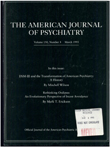The future of psychiatry: psychiatrists of the future
Abstract
OBJECTIVE: The authors' goal was to examine the changing demographic trends in psychiatry manpower. These changes have important implications for the practice of the profession in the future. METHOD: Each year, the APA Office of Membership, in collaboration with the American Association of Directors of Psychiatric Residency Training, conducts a census of all residents in psychiatry. A survey instrument is sent to the director of residency training in each U.S. program accredited by the Accreditation Council for Graduate Medical Education. Using data from this survey and from the American Medical Association, the authors conducted a study of the changes in the number of psychiatric residents over the last decade, particularly the increases in the number and percentage of women in medicine and psychiatry. RESULTS: They found that the number of psychiatric residents has grown from 4,674 in academic year 1978-1979 to 5,829 in 1987-1988, an increase of 25%. The percentage of women has increased from 32% of all psychiatric residents in 1978-1979 to 41% in 1987-1988. The largest proportions of female physicians and psychiatrists were found in the age groups younger than 35. CONCLUSIONS: Previously documented gender differences that affect practice patterns and career opportunities may very well change as a function of the increasing representation of women in the profession of psychiatry, and these changes need to be taken into account in planning for future patient care and research needs.
Access content
To read the fulltext, please use one of the options below to sign in or purchase access.- Personal login
- Institutional Login
- Sign in via OpenAthens
- Register for access
-
Please login/register if you wish to pair your device and check access availability.
Not a subscriber?
PsychiatryOnline subscription options offer access to the DSM-5 library, books, journals, CME, and patient resources. This all-in-one virtual library provides psychiatrists and mental health professionals with key resources for diagnosis, treatment, research, and professional development.
Need more help? PsychiatryOnline Customer Service may be reached by emailing [email protected] or by calling 800-368-5777 (in the U.S.) or 703-907-7322 (outside the U.S.).



